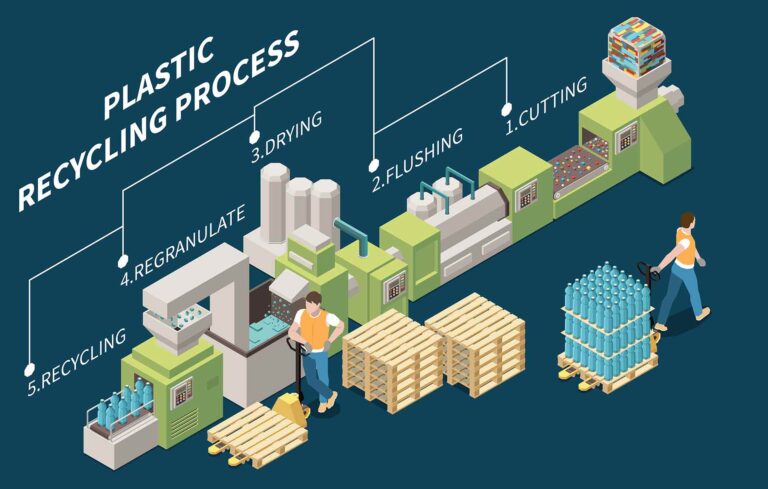- IELTS WRITING TASK 1 - PROCESS DIAGRAM
Plastic Recycling Process
You should spend about 20 minutes on this task.
Task: The diagram illustrates the process of plastic recycling, from cutting to the final recycling stage. Summarize the information by selecting and reporting the main features, and make comparisons where relevant.
Write at least 150 words.

Designed by macrovector | Freepik
Sample Answer, C1 English Level, Advanced, Band Score 6.5-7.5
Plastic recycling constitutes a multi-stage endeavor aimed at repurposing discarded plastic materials into valuable resources. The process begins with the preliminary cutting phase, wherein plastic items are meticulously reduced into manageable fragments. This preparatory stage lays the foundation for the subsequent phases in the recycling journey.
Subsequent to cutting, the plastic fragments undergo a flushing process, involving a thorough cleansing procedure to expunge any impurities or residual matter. This cleansing procedure assumes significance in upholding the quality of the recycled plastic material. Following this, the plastic fragments undergo a drying phase, eliminating residual moisture content. Adequate drying is imperative, as moisture can potentially impede the effectiveness of the recycling process.
Consequently, the dried plastic fragments are transformed into regranulate, a granular form that facilitates more efficient handling and processing. The regranulated plastic material serves as a pivotal intermediary, poised for the final stage: recycling. During the recycling stage, the regranulate material is utilized as a raw input in the fabrication of novel plastic products. This closed-loop approach diminishes the reliance on virgin plastic materials and concurrently mitigates the environmental footprint associated with plastic disposal.
Plastic recycling is a methodical way of giving a new purpose to used plastic materials, which is essential for the environment. This process involves several important stages that work together to transform old plastic into something useful once again.
The first step is cutting, where the plastic items are carefully chopped into smaller pieces. After that, the plastic pieces are cleaned thoroughly in a process called flushing. This cleaning is very important to get rid of any dirt or leftover materials. Once clean, the plastic goes through a drying process to remove any remaining moisture. This is important because too much moisture can cause problems in the next steps.
After drying, the plastic is turned into regranulate, which is a type of small plastic pellets. These regranulated plastics are easier to work with. The final stage is recycling, where the regranulate is used to make new plastic products. This helps reduce the need for new plastic and is better for the environment.
Plastic recycling is an intricate procedure that holds the potential to significantly mitigate environmental impact. The process unfolds through a meticulously orchestrated series of stages, each instrumental in reshaping discarded plastic materials into valuable resources.
The initial phase entails cutting the plastic items into smaller fragments, rendering them more manageable for subsequent processing. These plastic pieces then undergo a comprehensive flushing process, rigorously cleansing them to eliminate impurities and any residual contaminants. This thorough cleaning is paramount to ensure the quality of the recycled plastic material.
Once impeccably cleansed, the plastic is subjected to meticulous drying, effectively removing any remaining moisture. This step is imperative as excessive moisture can impede further processing. The dried plastic is then transformed into regranulate, granular particles that facilitate subsequent handling and manipulation. The culminating juncture in this elaborate journey is the recycling phase, where the regranulated plastic serves as a raw material to craft novel plastic products. By integrating recycled plastic, the demand for virgin plastic is alleviated, contributing to sustainable resource management and environmental conservation.

